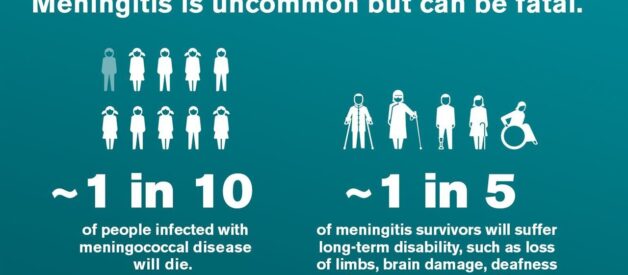(BPT) – Sponsored by GSK
A concurrent outbreak and cluster of meningitis cases have led to at least 44 cases across the state of Florida. While cases in the outbreak have appeared primarily among members of the men who have sex with men community and the cluster of cases among college students at one university1, anyone can get meningitis. Here are five things you need to know and the actions you should consider taking.
Who is affected by the current cases of meningitis?
The current outbreak and cluster of meningitis cases has included two different serogroups of the disease – serogroup B and serogroup C, and is impacting the following groups, for whom CDC is recommending two different meningitis vaccination considerations based on risk group1.
- College and university undergraduate students in Leon County, FL
- May receive meningitis B vaccination1
- Men who have sex with men (MSM) living in or traveling to Florida (with or without HIV)
- Should receive meningitis ACWY vaccination1
Meningitis ACWY (MenACWY) vaccination is also routinely recommended for 11-12-year-olds with a booster at age 16.2
Should college students in other counties/states receive meningitis B vaccination?
- CDC recommends meningitis B (MenB) vaccination for adolescents and young adults aged 16-23 years (preferably ages 16-18) based on a discussion between a healthcare provider and the patient/parent/guardian.3,4
- Colleges are environments prone to the spread of MenB: From 2011 through March 2019, MenB caused all U.S. college meningococcal outbreaks, which involved 13 campuses, 50 cases, and 2 deaths among an at-risk population of approximately 253,000 students.5
- Meningitis B vaccination has only been available since 2014, and seven out of ten 17-year-olds in the U.S. had not received one dose of meningitis B vaccination as of 2020.6,7
- Parents of high school and college students should check their child’s vaccination records and ask their healthcare provider about meningitis B vaccination.
There’s more than one ‘kind’ of meningitis
Meningococcal disease, also known as meningitis, is caused by bacteria carried in the nose or back of the throat that can spread through respiratory secretions, saliva and close contact. There are five vaccine-preventable serogroups – A, C, W, Y and B, and two different vaccinations needed to help protect against them, one for Meningitis ACWY and one for Meningitis B.2,6,8
Signs and symptoms
Early symptoms of meningitis may be similar to those of the flu but can progress rapidly. Symptoms can include fever, headache, and stiff neck as well as nausea, vomiting, rash, sensitivity to light and confusion.9,10,11
Because meningitis may initially present with flu-like symptoms, it can sometimes be difficult to distinguish its diagnosis from the flu or other viral illnesses.9
The best way to help protect yourself is through vaccination
Vaccination against meningitis is your best defense against the disease, according to the CDC.12 Those interested in helping to protect themselves or their college students against meningitis ACWY and meningitis B can find vaccination by getting in touch with their health care providers, pharmacy, local health department or community health center. For more information visit CDC.gov/meningitis.
Citations:
1. CDC. Meningococcal disease in Florida, 2022. Reviewed May 5, 2022. Accessed July 18, 2022. https://www.cdc.gov/meningococcal/outbreaks/FL2022.html
2. CDC. Meningococcal vaccination for adolescents: information for healthcare professionals. Reviewed October 12, 2021. Accessed July 18, 2022. https://www.cdc.gov/vaccines/vpd/mening/hcp/adolescent-vaccine.html
3. CDC. Recommended child and adolescent immunization schedule for ages 18 years or younger, United States, 2022. Reviewed February 17, 2022. Accessed July 18, 2022. https://www.cdc.gov/vaccines/schedules/hcp/imz/child-adolescent.html
4. CDC. ACIP shared clinical decision-making recommendations. Reviewed February 10, 2020. Accessed July 18, 2022. https://www.cdc.gov/vaccines/acip/acip-scdm-faqs.html
5. Marshall GS, Dempsey AF, Srivastava A, et al. US college students are at increased risk for serogroup B meningococcal disease. J Ped Infect Dis Soc 2020;9(2):244-247.
6. CDC. Meningococcal vaccination: what everyone should know. Reviewed October 12, 2021. Accessed July 18, 2022. https://www.cdc.gov/vaccines/vpd/mening/public/index.html#types
7. Pingali C, Yankey D, Elam-Evans LD, et al. National, Regional, State, and Selected Local Area Vaccination Coverage Among Adolescents Aged 13-17 Years – United States, 2020. Morb Mortal Wkly Rep (MMWR) 2021;70(35):1183-1190.
8. McNamara LA, Blain A. Meningococcal Disease in: Roush SW, Baldy LM, Hall MAK, eds. Manual for the Surveillance of Vaccine-Preventable Diseases. National Center for Immunization and Respiratory Diseases. Reviewed January 5, 2022. Accessed July 18, 2022. https://www.cdc.gov/vaccines/pubs/surv-manual/chpt08-mening.html
9. Pelton SI: Meningococcal disease awareness: clinical and epidemiological factors affecting prevention and management in adolescents. J Adoles Health 2010;46:S9-S15.
10. Thompson MJ, Ninis N, Perera R, et al. Clinical recognition of meningococcal disease in children and adolescents. Lancet 2006;367:397-403.
11. CDC. Meningococcal disease: clinical information. Reviewed February 7, 2022. Accessed July 18, 2022. https://www.cdc.gov/meningococcal/clinical-info.html
12. CDC. Meningococcal disease: prevention. Reviewed February 7, 2022. Accessed July 18, 2022. https://www.cdc.gov/meningococcal/about/prevention.html
